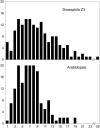Retention of induced mutations in a Drosophila reverse-genetic resource
- PMID: 18780737
- PMCID: PMC2535715
- DOI: 10.1534/genetics.108.092437
Retention of induced mutations in a Drosophila reverse-genetic resource
Abstract
Targeting induced local lesions in genomes (TILLING) is a reverse-genetic method for identifying point mutations in chemically mutagenized populations. For functional genomics, it is ideal to have a stable collection of heavily mutagenized lines that can be screened over an extended period of time. However, long-term storage is impractical for Drosophila, so mutant strains must be maintained by continual propagation of live cultures. Here we evaluate a strategy in which ethylmethane sulfonate (EMS) mutagenized chromosomes were maintained as heterozygotes with balancer chromosomes for >100 generations before screening. The strategy yielded a spectrum of point mutations similar to those found in previous studies of EMS-induced mutations, as well as 2.4% indels (insertions and deletions). Our analysis of 1887 point mutations in 148 targets showed evidence for selection against deleterious lesions and differential retention of lesions among targets on the basis of their position relative to balancer breakpoints, leading to a broad distribution of mutational densities. Despite selection and differential retention, the success of a user-funded service based on screening a large collection several years after mutagenesis indicates sufficient stability for use as a long-term reverse-genetic resource. Our study has implications for the use of balancer chromosomes to maintain mutant lines and provides the first large-scale quantitative assessment of the limitations of using breeding populations for repositories of genetic variability.
Figures


References
-
- Alonso, J. M., and J. R. Ecker, 2006. Moving forward in reverse: genetic technologies to enable genome-wide phenomic screens in Arabidopsis. Nat. Rev. Genet. 7 524–536. - PubMed
-
- Barstead, R. J., and D. G. Moerman, 2006. C. elegans deletion mutant screening. Methods Mol. Biol. 351 51–58. - PubMed
-
- Bentley, D. R., 2006. Whole-genome re-sequencing. Curr. Opin. Genet. Dev. 16 545–552. - PubMed
Publication types
MeSH terms
Substances
Grants and funding
LinkOut - more resources
Full Text Sources
Other Literature Sources
Molecular Biology Databases

